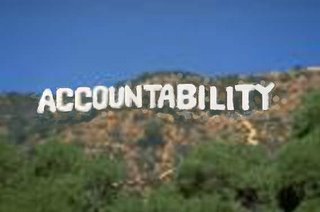Idea-log-ical {that is what we were planning to call the new feaure]
A bit of Pop Management [catchy title, eh?]
I am always on the look out for the latest book or article that falls within the broad domain covered by public administration, but over the years I have developed an aversion to those titles that make it onto the so-called "Management" shelves at the local mass market bookstore (typically Barnes and Noble or Borders). You know the kind of books I am talking about: The First Time Manager, How to Become a Successful Manager, 101 Biggest Mistakes Managers Make and How to Avoid Them, The Art of Managing People, The 21 Indispensable Qualities of a Leader: Becoming the Person Others Will Want to Follow, etc. Sure, there are some of those titles that may be worth reading for the PA academic, but I that I have been so put off by most of them that I typically wait until four or five of my colleagues mention the work in a positive way before I bother to use my Amazon One-Click to see what all the fuss is all about. Such instances are becoming rare indeed, but the titles of those that do make it onto my "read list" would be familiar to all: In Search of Excellence, Getting to Yes, The Gods of Management, almost anything by Peter Drucker, and (of course) Reinventing Government. I call the genre "Pop Management", and with those few exceptions (which often also disappoint) I am not a fan….
I bring this up because I am about to confess to having violated my own standard by picking up two recently published "Pop Management" books as they were released. In part this was because their titles and Amazon "blurbs" intrigued me. Also, at the time I was desperate to find a book or two that would not bore the hell out of my students in a "managing public organizations" course I was teaching this summer.
The books in question are The Starfish and the Spider and Everything is Miscellaneous. The first, by Ori Brafman and Rod A. Beckstrom, is an entertaining and quick read with little depth but one significant message: decentralized, leaderless organizations rule! The second, which turns out to be as much "Pop Metaphysics" as it is "Pop Management", is an entertaining read but with an even more significant message: disorder rules! Its author, philosopher David Weinberger, may have pulled off a rare scholarly coup by slipping a truly interesting work onto the Pop Management shelves of Barnes and Noble.
As the title of The Starfish and the Spider implies, the message is presented with a metaphoric hook that is pretty hard to ignore. The comparison they build on is striking. On the one hand you have the hierarchical, bureaucratized organization -- the spider which can be significantly incapacitated by pulling off any one of its legs, or completely done in by doing nasty things to its "head". On the other side are headless, regenerative entities -- the various forms of starfish which include some species that actually reproduce themselves when ripped apart. At the outset of the book, the contrast is used by the authors to explain historical phenomena that many have regarded as "strange but true" oddities; but as it turns out, what may have been idiosyncratic in the past may now be emerging as commonplace occurrences.
How, for example, do we explain the legendary endurance of the Apache nation in the face of European and (later) American efforts to conquer and subordinate the tribe. And in an era dominated by the transformation of social life through the corporatization and bureaucratization of everything, how do we explain the rise, success and proliferation of the non-corporate, non-bureaucratic model provided by Alcoholics Anonymous? Through these an similar examples, the book's authors demonstrate how the same starfish organizational logic found among Apaches and AA groups is at the heart of a number of "communities" that have emerged as strong challengers to those giant entities that have dominated their respective domains through traditional (spider-like) corporate forms. The examples are increasingly well known stories -- from Craigslist's challenge to newspaper advertising, to Wikipedia's challenge to Britannica, to the Napster/Kazaa/eMule challenge to the music industry giants.
As in the best (and worst) of the Pop Management genre, the Brafman and Beckstrom highlight a small number of factors (conveniently summarized as the "five legs") that characterize starfish organizations: circles, catalysts, ideology, preexisting networks and champions.
While I would argue that most of Pop Management literature might easily be dismissed as repackaged hogwash, I believe the starfish "has legs" (sorry about that) for research as well as pedagogic reasons. Their assertions about (and for) starfish organizations are clearly useful, not only for students of management and organizations, but also for analysts who are trying to make sense the problems faced by the US military in past (e.g., Vietnam) as well as current (e.g., Iraq, war on terror) conflicts (here the lessons of the Apache example of decentralized resistance is all too clear). And if you read the book with the critical eye of a scholar, there are a number of interesting research questions begging for testing.
But before you think I have fallen head over heels for this work, let me point out some major and interesting flaws. First and foremost, I believe they were careless in their decision to highlight "de"-centralization as a defining feature of starfish organizations. As Daniel Elazar brilliantly pointed out in his studies of federalism and related forms of governance four decades ago, there is a big difference between de-centralization and non-centralization, for the decentralized entity implies or assumes the pre-existence of a centralized arrangement. Returning to the metaphor, to think of the starfish as decentralized would be to assume that it "devolved" from a creature that was more spider-like rather than "evolved" from ancestors that were more mushroom-like. In that sense, Elazar's idea of non-centralization is more appropriate, for most members of the starfish genus consists of five radically symmetric protrusions, each emerging from an central disc that seems little more than a shared core and can be regenerated by any of the radials that become detached. By using the term "decentralization", Brafman and Beckstorm create an analytic ambiguity that makes their discussion of so-called "hybrids" less relevant than they might hope.
A second flaw is related to their narrow use of the term "leaderless" in characterizing starfish organizations. The authors seem to view the role of leader in strictly hierarchical terms while at the same time devoting space to the role of "catalysts" and "champions". A good deal more insight would have emerged from this work had they been more knowledgeable about the various ways and means so-called leadership manifests itself in modern organizations.
Despite these flaws, I could not help but think about how valuable the "starfish frame" will be in moving forward the conversations and research now being conducted into emergent forms of governance. Just as "reinventing" tag provided some coherence to the growing body of work on cut-back management and neo-managerialism of the 1980s, the starfish metaphor can provide a popular face for our work on networks and the changing face of leadership.
Weinberger's Everything is Miscellaneous, in contrast, does not suffer from significant or uninformed flaws. The subject is "order", and although the book is written at the level of Pop Management, its lessons rise to the level of profundity. In a sense, Weinberger's miscellany complements the starfish thesis by stressing the effective demise of authority and essentialism. The search for order is (and in fact always has been) an increasingly hopeless endeavor, and the adoption of the "digital disorderliness" that now pervades our cultural, social, political and economic lives will ultimately change "everything" by making any form of categorization and classification arbitrary at best. Rather than see this as the basis for gloom and doom scenarios, Weinberger paints a positive picture of the what is emerging (and already had emerged in some arenas) form this seeming chaos.
At the heart of his argument is the idea of the "three orders or order". The first order is comprised of the things themselves, whether they be books or students or clients or any such material objects which we seek to perceive as an identifiable population. The second order are those ordering mechanisms we use to track the first order things -- from library card catalogues to course rosters to client numbering (e.g., issuing social security numbers). The third order of order replaces the physical (atom-based) reality with a digitized (bit-based) representation which cannot be associated with any particular space or time, and in fact can be associated with any and many perspectives depending on who is doing the perceiving.
The implications are truly revolutionary, and Weinberger's examples range from a visit to Staples to the recent debate over how to reclassify planets, with stops in between at libraries, Wikipedia and Google maps. Weinberger does not offer simplified formulae of how to make millions in the coming disorderliness, and to that extent his work actually fails as an example of Pop Management. Nevertheless, Everything is Miscellaneous is a reframing of the future that all managers will face, no matter what "sector" they operate in. To some extent, the picture he paints of a world dominated by the third order of order is just a "digitized" version of the information society addressed by Harlan Cleveland and Peter Drucker, but in a very real sense the future has caught up with us -- and the question is are we prepared?
I suspect we will hear a good deal more about starfish organizations and the new order of things over the coming years. My own sense is that as a scholarly field we in PA are probably better prepared than most to engage in the discussions that are likely to develop.



